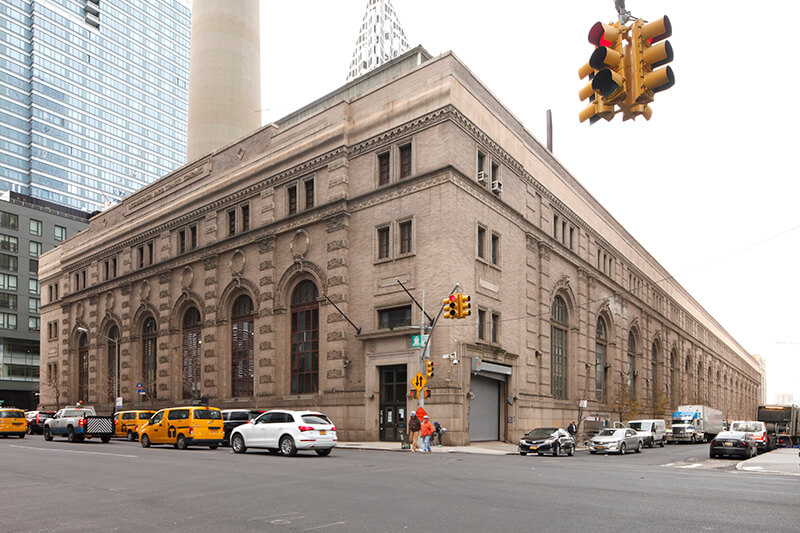
 Landmarks Preservation Commission311
Landmarks Preservation Commission311 Search all NYC.gov websites
Search all NYC.gov websites
Press Release
FOR IMMEDIATE RELEASE:
December 5, 2017
CONTACT:
lpcpressoffice@lpc.nyc.gov, (212) 669-7938
LPC Designates IRT Powerhouse as an Individual Landmark
Built in the early 1900s to power the city’s pioneering transit system, the IRT Powerhouse is a monument to the engineers and architects who planned and built New York City’s first successful subway system.

NEW YORK - Today, the New York City Landmarks Preservation Commission (LPC) designated the Interborough Rapid Transit Company (IRT) Powerhouse, now Consolidated Edison Powerhouse, at 855-869 Eleventh Avenue in Manhattan as an individual landmark. Occupying the entire block bounded by Eleventh and Twelfth Avenues, West 58th and 59th Streets, this mammoth structure was the largest powerhouse in the world upon its completion in 1904, and is considered the most monumental building associated with the subway system in New York City. The building continues to play a vital role in the city’s utility infrastructure as a steam and electric generating plant serving hundreds of Manhattan buildings including the Empire State Building and the United Nations.
“We are so proud to be designating this outstanding building that had been on the calendar for decades,” said Landmarks Preservation Commission Chair Meenakshi Srinivasan. “This building is both an engineering feat and an architectural treasure that has endured for over a hundred years. Our designation will ensure its long-term presence and enhance the streetscape with the majesty and craftsmanship of this beloved historic icon.”
When the IRT Powerhouse was built, it heralded a new era of electrified urban transportation. William Barclay Parsons, chief engineer of the Rapid Transit Commission, decided to run the new subway system using electricity, which was in its infancy as a form of motive power. The subway needed a powerhouse of unprecedented size, with a waterfront location facilitating the delivery of immense amounts of coal and the removal of waste ash. Planned by a team of distinguished engineers including John Van Vleck and Lewis B. Stillwell, a leader in developing alternating-current systems for urban railways, the IRT Powerhouse represented the highest level of technical sophistication in the production of electrical power at the time. It was capable of producing 100,000 horsepower and holding more than 30 million pounds of coal, with coal delivery and ash removal largely automated through a system of conveyors and hopper cars.
The exterior of the powerhouse was designed by Stanford White of the prominent firm McKim, Mead & White, and is a rare example of utilitarian design by that firm. Executed in the Beaux-Arts style and drawing upon Renaissance prototypes, it is the embodiment of the aesthetic ideas of the City Beautiful movement, which held that public improvements could beautify American industrial cities. White’s design masterfully concealed the boiler house and generating station with elegant, unified façades cloaked in Milford granite, Roman brick and creamy terra cotta with neoclassical ornament.
"This building is a magnificent testament to industrial power, and its obvious architectural and historical significance are why so many of us have worked for so long to see it landmarked," said Manhattan Borough President Gale A. Brewer. "This was a priority for landmark designation when I was a City Council member, and continued to be a priority for me as Borough President. I’m thrilled that we've finally reached this milestone, and that this wonderful building will be permanently protected as a city landmark."
“I am thrilled that the Landmark Preservation Commission is designating the IRT Powerhouse as the treasured landmark it is,” said Council Member Helen Rosenthal. “I commend the Commission for acting to preserve this piece of our city’s history—and future.”
“We congratulate the Landmarks Commission and Con Ed for preserving this magnificent structure which is a glory of the West Side and an architectural and engineering marvel,” said Peg Breen, President of the New York Landmarks Conservancy. “This is truly a designation to celebrate.”
In 1959, the Consolidated Edison Company of New York, which at the time was the largest electric utility in the world, acquired the IRT Powerhouse. Con Edison upgraded its equipment and continued to use it to generate power for the transit system for a number of years before converting it to a generating plant for the city’s steam system, the largest in the nation.
While the building has been adapted to meet evolving power needs, and alterations have been made to the façade and roofline including the removal of the original smokestacks, the IRT Powerhouse, now Consolidated Edison Powerhouse, retains its classical grandeur, memorializing in impressive form the original subway system. As an architecturally significant and functionally flexible structure designed for the production of power, it has remained in continued use as a power station.
###
About the Landmarks Preservation Commission (LPC)
The Landmarks Preservation Commission is the mayoral agency responsible for protecting and preserving New York City’s architecturally, historically and culturally significant buildings and sites. Since its creation in 1965, LPC has granted landmark status to more than 36,000 buildings and sites, including 1,398 individual landmarks, 120 interior landmarks, 10 scenic landmarks, and 141 historic districts and extensions in all five boroughs. For more information, visit www.nyc.gov/landmarks and connect with us via www.facebook.com/NYCLandmarks and www.twitter.com/nyclandmarks.


